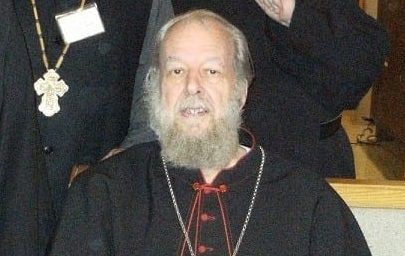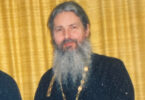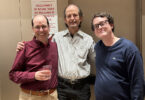Your Grace, what is the relevance of the Western Rite today?
The relevance is in the fact that there are many converts in the Orthodox Church today. I am among them, of course. And we feel that, even though our parents, grandparents, and more recent ancestors were not Orthodox, a thousand years ago our ancestors were Orthodox. This was their liturgical tradition, and we, for that reason have a love for it, a desire to return to it, to build on it again as part of the general heritage of the Orthodox Church.
What is the place of the Western Rite in the history of the Orthodox Church?
The Orthodox Church has many ancient liturgical traditions. Of course we have the Greek tradition, the Russian tradition, and there are others. We have the Alexandrian tradition with the liturgy of St. Mark, the Jerusalem tradition with the liturgy of St. James, and of course there is also the Western tradition. The importance of that is not only for those who love a particular tradition, but also for students of theology and students preparing for the priesthood because, just as knowing one foreign language makes it easy to learn another, so knowing more than one form of the divine liturgy and other services makes it easier to understand other forms.
When and how did the Russian Orthodox Church first permit the usage of the Western Rite?
The Western Rite was first officially permitted in 1870 when the Holy Synod in Russia approved a form of the Roman Rite known as the Overbeck Liturgy, in Latin, for those who joined the Orthodox Church from a Western Tradition, although for a long time it did not have much development. But in the beginning of the twentieth century, when Patriarch St. Tikhon was here in New York and built St. Nicholas Cathedral on 97th, Street there was Western Rite congregation that served in the left-hand chapel of that cathedral up until the time when the revolution disrupted church life and the “Living Church” seized the building. That chapel was used again for the Western Rite starting in 1962, which was also the same time that the Church Abroad, under the direction of St. John Maximovixh received a group of Western Rite parishes in France. They had been part of the Russian Church since 1936, but in 1962 a large number of them joined the Russian Church Abroad. St. John Maximovich was their great supporter and defender.
You mentioned, Vladyka, about the development of the Western Rite at 97th Street. Did this some how provoke the Russian Church Abroad to accept the Western Rite, since the Moscow Patriarchate already had their own Western Rite community? Or was there no relation between the two developments?
I think that there may have been some relationship, because just as the Moscow Patriarchate lifted the ban on the Old Rite, so the Church Abroad did the same thing a year or two later.
In my understanding the history of the Western Rite has been somewhat problematic. Can you please point out a representative of this tradition who has been stable and loyal to the Orthodox Church?
There are several of course. The most stable was the late Abbot Augustine (Whitfield), who had come into the Orthodox Church in 1962 and in 1975 came from the Moscow Patriarchate into the Church Abroad. He was not only loyal but very stubborn. He would not give in to any pressure, but insisted on continuing in the Western Rite, which he had received a blessing for. As a result of his stability — he was a Benedictine monk — the idea of the Western Rite was always preserved from 1962 until the present time.
I understand that in the 1970’s the Russian Church Abroad decided not to accept any more Western Rite parishes. Could you comment on this?
First of all, when that decision was made they had forgotten about Fr. Augustine. I wrote a letter about it to Vladyka Laurus at the time and he replied to me that in that case the decision was not valid because Fr. Augustine was allowed to continue with the Western Rite.
My understanding it was just decided not to list Fr. Augustine’s information in the directory. So, whereas he continued with the Russian Church Abroad as the only Western Rite community, his address was not published.
Actually, he was the one who requested that. The reason was that Russian people were starting to find him and he could only speak a few words of Russian, so he had a sort of embarrassment with that.
So, it was for very different reasons than what I thought it was. Would you tell us about your Abba’s, Vladyka Nikon’s, attitude about the Western Rite?
Vladyka Nikon (Rklitskii) was very supportive of the Western Rite. He told me that Metropolitan Anthony Khrapovitsky, who had been his Abba, had been strongly in favor of it. Although he didn’t write anything about it, Vladyka Nikon knew him closely and personally and said that he supported it. Therefore so did Patriarch Tikhon, so did St. John Maximovich and other students of Met. Anthony, such as Met. Sergei (Stragorodskii). They all had the same opinion, which they had learned from [Met. Anthony]. Vladyka Nikon also was the one who, through his personal friendship with Fr. Augustine, encouraged him to come into the Church Abroad at a time when there were difficulties with the Moscow Patriarchate. So it’s thanks to Vladyka Nikon that the Western Rite continued.
Thank you, Vladyka. How has the position of our Church changed since the decision in 1978?
In 1991 Vladyka Hilarion, who then was Bishop of Manhattan, received Fr. James (Deschene), who is now an archimandrite. He lives in Canada and has a monastery there in the Western Rite with a few monks.
Your predecessor.
Yes.
I understand from my conversation with His Eminence today that our Church recently adjusted our approach toward the Western Rite, so that now it’s officially part of the Russian Church Abroad.
Yes. It was at first the Metropolitan’s ruling, then the Synod decided in 2010. There was a Synodal decision to create a vicariate of the Western Rite. The Sobor of 2011 confirmed that and officially established the Western Rite vicariate and made me the vicar bishop. The Metropolitan is the Ruling Bishop for all the Western Rite churches, but I serve as his Vicar.
Would you please explain if the services of the Western Rite that have been in use in the Russian Church Abroad find their roots in Anglican practices?
Not in Anglican practice, no. They find their roots in Roman practice. One of the groups in Iowa uses the restored Gallican Rite that was approved by St. John Maximovitch.
I understand that some parishes celebrate feasts established long after the schism, such as Corpus Christi, the Seven Sorrows of the Blessed Virgin Mary, and the Feast of Christ the King. Could you comment on that?
Well, the Feast of Christ the King — we have a church dedicated to that, so there’s a tradition to celebrate it on the last Sunday of October. We do have that. But the others are not celebrated in our Western Rite. Corpus Christi and the Seven Sorrows — those are in the Antiochian Western Rite. We do not have them.
That feast Corpus Christi was probably introduced during the Council of Lyon in 1274.
Yes, very likely.
And Seven Sorrows was even later, the early 19th century, by Pope Pius.
Well, we definitely don’t have anybody keeping the Seven Sorrows, and I’m not sure that the Antiochians even have that, but we don’t.
Thank you Vladyka. Do the clergy wear Western Rite liturgical vestments and ecclesiastical daily attire?
I think that most of our Western Rite priests do use the same clothing on the street as the Russian clergy do. Many of them wear beards and look Russian. I know that in Germany, where we just received a monastery, the abbot there wears Western clerical attire, but I think he uses Russian clerical attire when he goes to events with Russian clergy. I have a Western style bishop’s cassock, but it’s almost identical with the Old Rite bishop’s cassock that Bishop Daniil wore.
Could you contrast Roman Catholic Uniates with Orthodox Western Rite parishioners? Is the dynamic similar? Can one call them “our Western Rite Uniates”?
No. First of all, the Uniates in the Roman Catholic Church did not join out of conviction. The initial ones in Europe joined out of pressure from the civil authorities. The ones in the Middle East were led into joining for other reasons. They were promised education or political protection or something like that, whereas the Western Rite clergy and parishioners all have joined of their own desire and conviction. I would say that the majority of the Western Rite parishioners had already joined the Orthodox Church before they became interested in the Western Rite. So although it’s a minority rite in the Orthodox Church, it has a completely different history.
So whereas in the Roman Catholic Church the final intention was to bring them closer to the Latin Rite (it was just a transitional stage), with us this was not an objective.
No. All of our Western Rite clergy are allowed to serve in the Byzantine Rite if they know how, but they have to know how to do it correctly.
Do Orthodox Christians of the Western Tradition have brotherly relationships with Orthodox Christians of the Byzantine Liturgical Tradition.
They do. They are welcomed by many.
It’s not like they are avoided?
No. Some who have had bad experiences become hesitant. But when they are welcomed everything is fine.
So there are cases of cooperation.
Yes, many cases.
You have served at parishes in the Mid-West, so have also had relations with the faithful there.
We have one fairly large parish in Iowa. That’s the one that uses St. John Maximovich’s Western Rite. I served there last year. They have a lot of people, but don’t have their own building. The Greek priest came. He had already celebrated the Liturgy earlier that morning, but he was at our service and was very friendly.
Do the Western Rite clergymen know how to serve Byzantine Liturgies?
Many of them do.
Do we need to consult other Orthodox Churches regarding the reception of Western Rite parishes and clergymen, because not everyone in the Orthodox world is on the same page regarding the Western Rite? We are setting a precedent, opening a door, when other Churches have no intention to receive them whatsoever.
Well, we have very fraternal relations now with the Antiochian Western Rite Vicariate. Some of their clergy joined us for a conference the year before last, and just a few months ago, when I did some ordinations for the Western Rite, the Antiochian Bishop Thomas and his priest, who accompanied him, joined us. The bishop received Communion at the Western Rite service and his priest concelebrated. Where it’s possible we have very good relations.
How many communities of the Western Rite do we have right now?
We have thirty communities in the western hemisphere including Canada. We just received a monastery in Germany. There is a group in Italy which is working on joining us now. But they will be under Archbishop Michael of Geneva. All the others are under the Metropolitan. I understand that we have a number of clergy that are preparing for ordination in the Western Rite. We already have about fifty clergymen, and there are another eleven candidates.
What documents regulate their inner life? Do they use the normal parish by-laws, everything that a regular ROCOR parish would use to regulate its life?
We have one large parish outside Philadelphia, Christ the Savior, and I believe they have the same by-laws as other parishes. But most of these are small missions and they aren’t large enough to have all of the things described in the by-laws. Some of them have five people, ten people, fifteen. So everybody is on the parish council. It isn’t practical yet but, as they grow, they will follow more and more the same parish by-laws as everyone else.
What are your responsibilities concerning the Western Rite?`
My responsibility is, of course, first and foremost the performance of ordinations according to the Western Rite, not according to the Byzantine Rite. I visit parishes, of course, the same as the Russian parishes. I advise. I am quite often consulted about details and so forth. It’s about the same as with the Russian parishes.
What would you say to Russian parishes that have never been exposed to the Western Rite? Why would the Russian Church Abroad need to have them? Many people will say, “Why don’t we just take them on our terms, so that they will accept the Byzantine Rite?”
Those Russian people who have been exposed to the Western Rite usually don’t have any problem with it. I met a group of Russians when I served in Virginia at one of our churches. Of course, I put a little Slavonic in. We have some Russians who have joined the Western Rite parishes. There’s a man named Victor in Philadelphia who goes to the Western Rite church and taught in the Sunday School there. That parish has a choir director from Lithuania. When I was in Germany there was one lady from Ukraine going to the Western Rite church there. There’s a German lady who’s going to convert to Orthodoxy and marry a Russian, but in the German Western Rite church.
Vladyka, did you have a chance to raise the question about the Western Rite in Moscow? Do they know about our Western Rite deanery and, if they know, what is their attitude toward our Western Rite?
They certainly know about it. I didn’t hear anything negative when I was over there. But I had a conversation with the Patriarch about ancient liturgies in general, and he told me that when he taught in the seminary he found it very helpful for his students when these ancient liturgies where celebrated there because it helped them to understand the usual liturgy.
You not only have translated these liturgies but also serve them. Is this part of the ancient diversity that you mentioned?
Yes. There is a direct connection. One of the ancient liturgies is the Liturgy of St. Peter, which is a form of the Western Rite that is preserved on Mt. Athos, of all places. It exists in Greek, in Slavonic and in Georgian. I translated the Slavonic form, which is preserved in the manuscripts of the Hilandar monastery, into English. Three of our Western Rite parishes liked it so much that they began using that service as their regular order. That sort of bridges the gap. That same manuscript in the Hilandar monastery also contains the oldest known version of the liturgy of St. James.
Thank you very much for your time, Vladyka. Your comments have been very informative.
Conducted by Deacon Andrei Psarev
- On the Western Liturgical Tradition
- Bishop Jerome of Manhattan Presents a Nuanced Portrait of Archbishop Nikon of Florida
- Bishop Jerome of Manhattan on Conciliarity Spirit in the ROCOR
- Bishop Jerome of Manhattan: Interview Regarding the Reconciliation
- A Brief Autobiography of Bishop Jerome of Manhattan












[…] liturgical tradition, and we, for that reason have a love for it, a desire to return to it, to build on it again as part of the general heritage of the Orthodox […]
I pray for Bishop Jerome’s vindication and the success of the Western Rite clergy. While our pasts are somewhat different our goals are the same to fulfill Jesus’ prayer that we all may be one even as He and the Father are one.
Carson Lauffer, Byzantine Catholic
Eastern Orthodox Rite tradition is the “glue” holding Orthodoxy together. When Catholics/Protestants convert to Orthodoxy they must accept Byzantine Rite, or stay where they
are, if they are so attached to it. Returning to Western Rite, inevitably leads to acceptance of other non orthodox traditions. ROCOR has erred by allowing it and has now realised it. Latest decisions by the Holy Synod regarding Bishop Jerome’s activities bear wittness to that.
Lord help us to be ONE in Holy Orthodoxy!!
To hold this attitude is to deny the Catholicity of our Orthodox faith. Being ONE, or universal does not directly imply a set Rite across the scope of Orthodoxy, to be clear it NEVER did. To quote Anderson on his short essay regarding the Western Rite,”The modern Western Rite movement within Orthodoxy (beginning in the late 19th century) sees itself as a restoration of the ancient Western expression of the Orthodox Catholic Faith, which existed in communion with the Orthodox Churches of the East in the first millennium of Christian history. There were, from the beginning, a number of local liturgical families, centered around important sees of East and West, developed from the very beginning. In the words of Father Alexander Turner, “As the Holy Spirit moved the hearts and souls of various races, each responded according to its own endowments, to develop our present liturgical families.” A western and Eastern Orthodox’s statement of faith is the same, the Creeds are the same, the theology is the same. Just because the west and east have different expressions or endowments, does not hinder the Orthodox faith in any way from growing, especially in our western culture. Having a take it or leave it mentality with regards to conversion to the Byzantine Rite or nothing at all, is heretical to the Catholic nature of the Church.
As for being a “glue”, unfortunately it is often a glue that keeps outsiders away. While some non-Orthodox do not care if a church is associated with an ethnic group or liturgical tradition they are not part of — “American” neighbors who live near our wonderful Russian parishes can be aware of the church all their lives but never even consider going inside. If we believe that Orthodoxy is the true faith, then certain logical deductions follow.
In reading Mr. Kischkowski’s reply and Bishop Jerome’s response I feel obligated to offer the following comments:
If the name on the marquee announces the church as Greek, Russian, Serbian, etc., that is most likley the “glue” that keeps other’s from going inside. Bishop Jerome says as much when he says that “‘American’ neighbors who live near our wonderful Russian parishes can be aware of the church all their lives but never even consider going inside.” If they never went inside it certainly wasn’t the Byzantine Rite that kept them away. The Byzantine Rite can be and is celebrated in English in many Orthodox Parishes–(many of them being convert and or mission parishes). Lastly, the Byzantine Rite is indeed much of what holds Orthodoxy together since our liturgy is an expression of our theology. Lex orandi, lex credendi!
First of all: if they never went inside, how would they even know what Rite was celebrated? The ethnic label had been enough to make them feel this church was not relevant to them. But the fact that people did not get far enough to see the order of services, does not prove that the rite was unimportant. At least for us in ROCOR, the idea of being “in the Russian Church” includes language, tradition, art and architecture, music, and everything else.
But, if the American neighbors do not get as far as the inside of the church, there is a serious problem with young people ceasing to “feel Russian”, and drifting away.
The presence of the Western Rite, if properly understood, demonstrates that the West was, and should still be, part of the Orthodox Church. Just as the Armenian, Coptic, Syriac, Ethiopian and other “Lesser Eastern” Churches used to be part of Orthodox Christianity, and their members often still feel that they are, so the Latin Church found its spiritual home in the same Orthodox Christian world as the Russians, Greeks, Georgians, Romanians and many others. It is an incorrect, narrow view to identify “Orthodoxy” with “Byzantium”, when at one time all these nations, each with their liturgical and spiritual traditions, made up the one Orthodox Church. And those who have taken the trouble to study the different ancient Liturgies, including the Latin, can see that the underlying theology is the same.
Blah, blah, blah….It’s all a mystery to me!
It is not answer.
Although I was raised Catholic, after leaving the Catholic church, I never experienced any nostalgia whatsoever for the rituals of it. As with everything, it seems, there is an “ideal way,” and “the way things happen.” While I am most certainly no authority on the Western rite as it has been utilized within Orthodox Churches, from what I understand, it seems the “adoption” of the Western rite, in various places and times by different Orthodox Churches was about as far from the “ideal” as it could possibly have been. It seems to have been plagued by the “adoption” of “Western rites” that were not used at all during the time “all these nations” were “in the same spiritual home,” as well as, in some cases, an extremely poor choice of persons to propagate the Western rite (by no means do I include Vladika Jerome in that category). While I may be overstepping the case with the following, some excuses … or apologies, reasons … what have you … for the Western rite’s existence within Orthodoxy remind me of the excuse Catholics gave for “clown masses,” “rock masses,” “folk masses,” etc. How far does one go to “attract?” The Catholic “variants” mentioned seem to have had no great success …
First of all, we do not have “clown Masses”, or “rock Masses” (though in Russia and elsewhere today, there are “Orthodox rock groups”, though I doubt they have anything to do with the Western Rite!).
As for “folk Masses”, it should be remembered that there is a kind of “ecclesiastical folk music” in the Carpatho-Russian and [in parts of the] Romanian Orthodox traditions. A main motivation for those who seek Western Rite Orthodoxy, is the desire to follow the genuine, ancient, Orthodox liturgical traditions of the West — which, contrary to popular belief, are quite thoroughly documented.
What I have always tried to do, is to follow those ancient Western forms — which are mostly the same in in their general structure as those that were followed in the Roman Church prior to Vatican II, and in some Anglican communities (such as the convent in Wantage) till within recent memory.
As for success, the main reason we came under attack recently, was specifically that the ROCOR WR was starting to bear more and more fruit, and several large groups (one of them huge) were on the verge of joining us — even half a million people in Guatemala, who were already officially petitioning the Synod, and seemed to get a positive response from our bishops at the 2011 Sobor — till suddenly their hopes were dashed. So I feel it’s a bit unfair that on the one hand, WR missions have tended to be attacked and blocked, but on the other hand, a key argument against the WR is that it “has not borne fruit”.
There is also a difference between “nostalgia” and realistic understanding: most Western people are not seriously considering joining “foreign” churches — unless sometimes through marriage, or in even fewer cases, through serious personal study and conviction (as I did myself). But where they encounter a parish they can “relate to”, feel they can understand both the language and the order of service, conversion becomes simply a spiritual matter, rather than one of adopting another culture.
+Bishop Jerome
I did not suggest that “we” have clown masses, etc., but that some of the reasoning behind use of the western rite and that type of thing is the similar. Carpatho-Russian “folk music” is worlds apart from the “folk music” that spurred Roman Catholic “folk masses”- that is, the “protest songs” of the 60s … which was not appreciated by a large segment of the “folk,” and entirely political and what was then thought of as “revolutionary” in content. As was mentioned about “identifying” or “being able to follow” western liturgical forms … similar in structure to “pre Vatican II Roman Catholic” forms, it would seem that the ability to “identify” with that would be limited to a very few … as those “forms” were discarded by Rome 50 years ago. I was not attempting to issue a blanket condemnation, only stating some of the problems and missteps that have occurred, and that these have contributed to opposition against the western rite.
I might add … the Roman Catholic impetus for “folk” and “rock” masses was based on some thought that it would make the mass “relevant” to younger people who were “fans” of that music. A very superficial, and seemingly desperate attempt to “regain” those who had “strayed,” or might … while completely ignoring that the reason for being of what was called “folk music” in the 60s, and rock music, were anything but “Christian.”
And to add to that “oversight,” the music was always done horribly …
Synodal decisions are synodal decisions … Our biggest problem with synodal decisions has been the fact that those seeking “legitimization” have been taken at their “word,” with little or no verification that their “word” means anything … which has, unfortunately, at times, ended in disaster with people getting scandalized, and hurt … I understand that “the Bishops are trusting,” and, I understand why, but it seems “twice bitten” might have brought about a bit of “shy!”
Всё равно кто-то должен заниматься Западным обрядом в лоне православия. Ведь не обрядом же люди спасаются, а истинной верой и участием в таинствах.
Для меня появления западного обряда в Русской Зарубежной Церкви было добрым знаком, показателем того, что Русская Зарубежная Церковь, сохраняя православную веру, не замыкается национальны рамках. Церковь должна иметь вселенское мышление (не в плане подчинения “вселенскому” патриарху, а в плане охвата всего Православия и всей истории Православия).
Надеюсь, что всё более-менее успокоится, и западную миссию всё же “раскосервируют”.
Молюсь за владыку Иеронима; убеждён, что хотя он и сделал ошибки, он не желал зла.
.Спаси Господи за Ваши добрые слова!